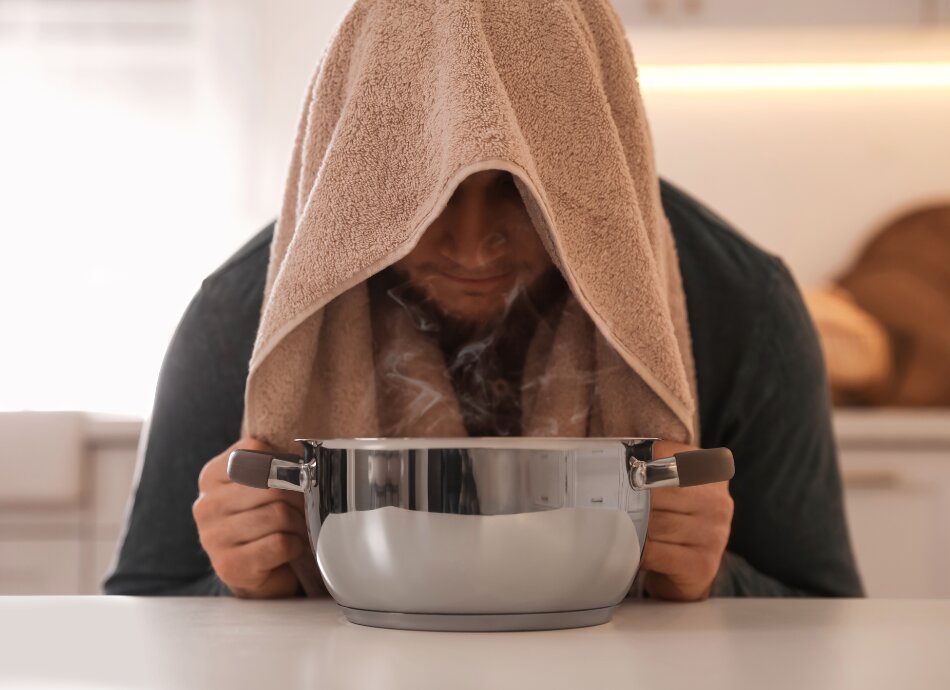Steam inhalation
Key points about steam inhalation
- Inhaling steam has been used as a home remedy for colds and nasal congestion (blocked nose).
- Steam inhalation is no longer recommended. Scientific studies have found that it has few proven benefits and can cause serious harm like burn injuries.
- There's no evidence that inhaling steam is effective for treating or preventing COVID-19 – in fact it may do more harm than good.

Steam inhalation involves breathing in steam from heated water. Many people do this to soothe and open their nasal passages when they have a cold or sinus infection.
Why inhaling steam isn't recommended
|
Steam inhalation is a hazard – particularly for children. It can cause burns and scalds and ultimately lead to hospital admission, surgery, and life-long disfigurement. |
To inhale steam, people mostly use bowls with hot or boiling water and some use commercially available steam inhalers. This use of hot, or boiling water is a huge risk, particularly to children. Children, due to their unpredictable movements, curiosity, and poor awareness of danger, are at significant risk of burn injuries.
Breathing in very hot water can damage the lining of your lungs. It can be particularly bad if you have asthma as it can worsen your asthma symptoms.
Some people add eucalyptus oil to the water, thinking that the scented steam will clear their blocked nose. This is dangerous as there have been reports of eucalyptus inhalation causing epileptic seizures (fits). The same can happen if other essential oils are inhaled. Read more about essential oils.
There is no evidence that steam inhalation is effective for the treatment or prevention of COVID-19
Steam inhalation has long been considered a beneficial home remedy to treat nose and chest congestion, but there is no research evidence to suggest it actually works. Social media and home-made tutorials have played a role in misleading people into thinking that breathing in steam will unblock airways and kill a virus. There is no evidence that steam inhalation is effective for the treatment or prevention of COVID-19. In fact it may do more harm than good.
It is common for babies aged under 6 months to have a blocked nose (commonly called 'snuffles'). It is usually due to normal mucous that collects in the nose, which is difficult for the baby to clear. No treatment is required if the baby is otherwise happy and feeding well.
Here are some safe things to try if feeding becomes difficult:
- Give your baby a warm bath. If they can sit up they will enjoy some playtime and distraction and warm water can help loosen mucous and clear congestion.
- Try placing a bowl of warm water in the room where the baby sleeps. This raises the humidity which may help to loosen thick mucous.
- Try sitting in a steamy atmosphere with your baby before a feed. For example, run the hot shower in the bathroom and shut the door. Sit in the room, but not in the shower, with your baby for five minutes before feeding.
- Try giving smaller but more frequent feeds.
- Run a humidifier in your baby's room while they sleep.
- Salt water (saline) drops or sprays may be useful if the above measures do not help. Saline drops thin the mucus and so make it easier for the baby to clear the mucus from the nose. (Saline seems to work better than just plain water.) You can buy saline drops from a pharmacist who can also advise on how to use them. Only use the drops just before feeds, and only if the nose is blocked. If saline is used too often, the skin around the nose may become a little sore.
Apps
Self-management and healthy living apps
Breathing apps
References
- Heated, humidified air for the common cold(external link) Cochrane Database Syst Rev. 2017; 2017CD001728
- Steam inhalation and paediatric burns during the COVID-19 pandemic(external link) The Lancet, May 2020
- Matthew T, Kamath V, Kumar RS, et al. Eucalyptus oil inhalation–induced seizure – a novel, underrecognized, preventable cause of acute symptomatic seizure(external link) Epilepsia Open 2017;2(3):350-354.
- Blocked nose in babies(external link) PatientInfo UK, 2017
Credits: Healthify editorial team. Healthify is brought to you by Health Navigator Charitable Trust.
Page last updated:





